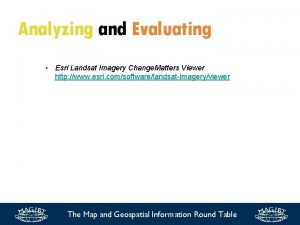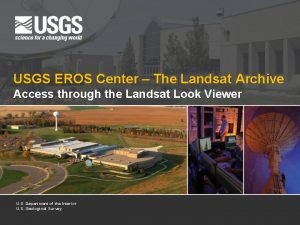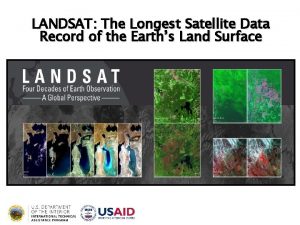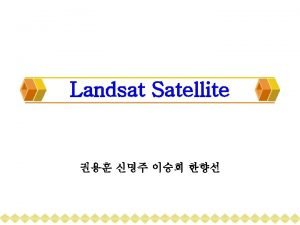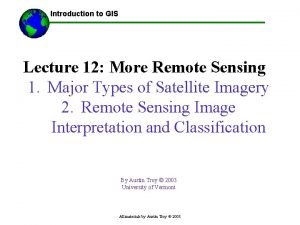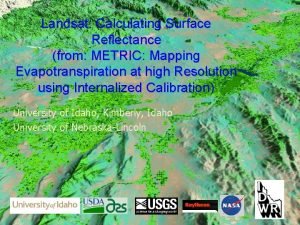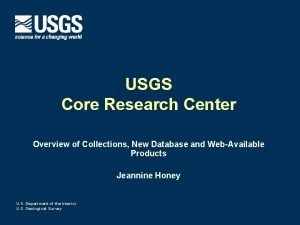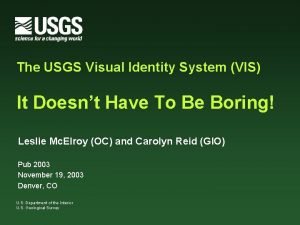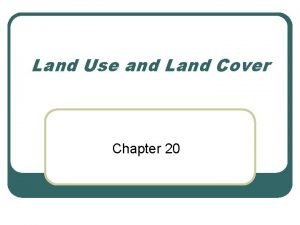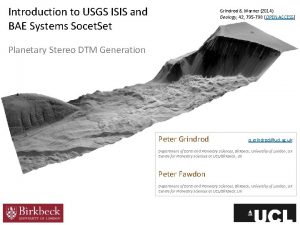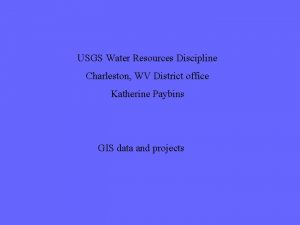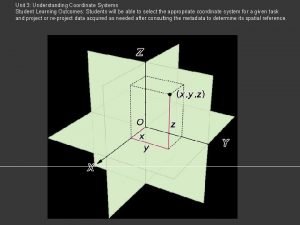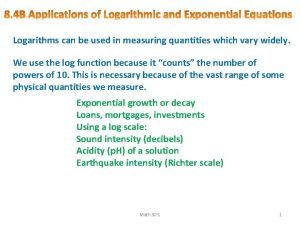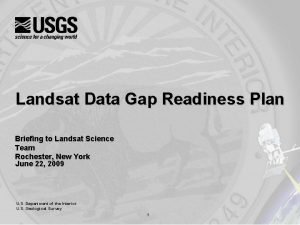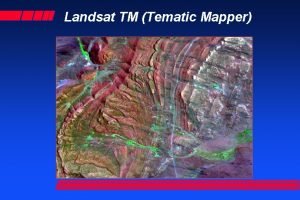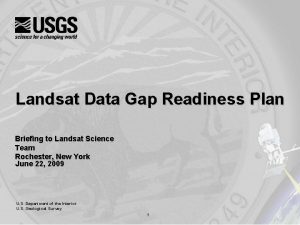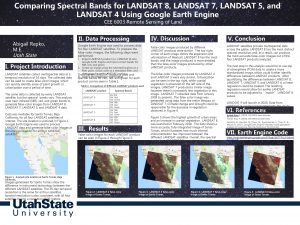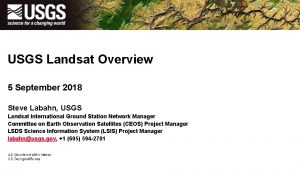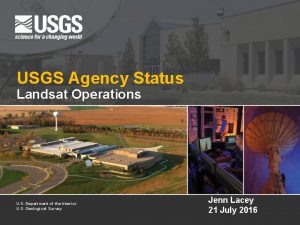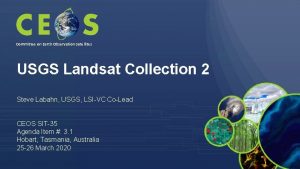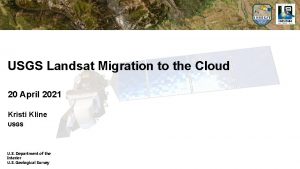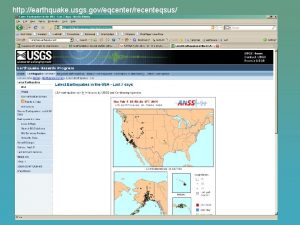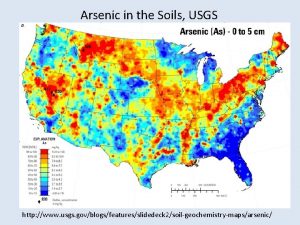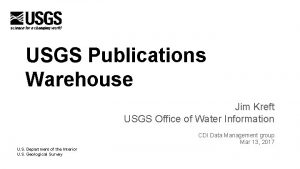USGS Plans for Landsat Science Products Landsat Science

















- Slides: 17

USGS Plans for Landsat Science Products Landsat Science Team Meting - March 3, 2011 John Dwyer, Tom Loveland, and Tom Maiersperger U. S. Department of the Interior U. S. Geological Survey

Synthesis of Boston Science Team Discussions on Products

General Product Priorities & Considerations · · Surface Reflectance (foundational, endorsed, in progress) · · LEDAPS for scene-based WELD for composites · Note: Hybrid approach is feasible as branch in algorithm when better (e. g. MODIS) ancillary data is available Land Surface Temperature (foundational, endorsed, in progress) · · Scene-based NASA FY 11 support, USGS FY 12 -13 support Land Cover (foundational, endorsed, development TBD) · · Upstream dependencies on Surface Reflectance composites from WELD Two needs – LCOV for end-user (more complex), LCOV for modeling/algorithm stratification (simpler) LAI / f. PAR (in progress) · · Would benefit from 30 m Land Cover Scene is building bock, can consider composites, but be cognizant of phenology

Specific Near-Term Recommendations · Surface Reflectance · · USGS should continue developing a Surface Reflectance production capability based on the LEDAPS atmospheric correction approach USGS should stay in sync with LEDAPS algorithm refinements and code changes USGS should establish a plan to generate and provide Surface Reflectance scenes for both internal and external validation and evaluation Once validation and evaluation needs are met, USGS should bring the results together in a workshop

Background · USGS considers climate data records (CDRs) and · · essential climate variables (ECVs) necessary for terrestrial monitoring Advocacy and encouragement by Landsat Science Team USGS interests and efforts would be complementary to NOAA CDRs and useful in validating GOES-R advanced baseline imager (ABI) data products Geography Science Centers were directed to initiate a strategy for developing Landsat-based CDRs and ECVs CEOS Working Group on Climate considers Landsat important for the development and validation of terrestrial ECVs

USGS ECV Science Strategy · · · · Respond to requirements for quantitative information on land surface change Intended to inform USGS Programs and Projects and solicit feedback – eventually distributed for broader review and comment Address the needs of Federal science and land / resource management programs Responsive to international program needs (GCOS) for higher level satellite data products Leverage previously demonstrated capabilities from NASA research missions (e. g. MODIS) through collaborative partnerships Work with the Landsat Science Team to develop capabilities and perform product validation Conduct initial product evaluation through USGS and DOI projects

Status of USGS Landsat Science Data Processing · · EROS Science Processing Architecture (ESPA) framework development – modular design of science computing capabilities with scalable capacity Leverage existing EROS enterprise capabilities for data access (Landsat online cache), storage and distribution (LP DAAC and the Long Term Archive) LEDAPS software integration into ESPA – will use the new version of LEDAPS to establish baseline Implementation of WELD distribution system and Version 1. 5 data for 2006 – 2010

Partnerships · · Web Enabling of Landsat Data (WELD) – David Roy, South Dakota State University Landsat Ecosystem Disturbance Adaptive Processing System (LEDAPS) – Jeff Masek, Feng Gao (NASA GSFC), and Eric Vermote (UMD) Deriving Biophysical Products (LAI, f. APAR) from Landsat Data – Rama Nemani, NASA Ames Research Center Land Surface Temperature – John Schott (RIT) and Simon Hook (JPL)

Initial Focus · Surface reflectance – LEDAPS and WELD · Land Surface Temperature – funded by NASA Lc. PSO in FY 11, USGS to assume funding support in FY 12 -13 · Land Cover – Global 30 meter initiative · Strengthen role of Landsat Science Team collaboration

Near-term Plans · Perform Initial Product Validation · · · · Adopt methods and complement existing work (Vermote, Huang) AOT retrievals vs. Aeronet Surface reflectance retrievals vs. field data (vicarious calibration sites) Up-scaled product comparisons to MODIS daily surface reflectance (MOD 09) NEON airborne observation platform Applications performance testing and evaluation Develop a “Quick Guide” to Products · · WELD and LEDAPS product summaries Links to WELD and LEDAPS data access and documentation

Near-term Plans · Perform on-demand processing for evaluation by select users · · · EROS scientists USGS Science Centers Landsat Science Team LP DAAC User Working Group Existing users of LEDAPS software and products Solicit feedback on products · · · Fitness for use – extent to which products successfully meet the needs of end users Benefits over standard L 1 T data Description of methods used for validation / evaluation

Near-term Plans · Characterize product quality and levels of service · · · Sufficiently free of error for needs? (e. g. , accuracy, anomalies, artifacts…) Sufficient specifications for needs? (e. g. , file format, bands/parameters/processing level, precision/scaling/bit depth, temporal/geographic coverage) Sufficiently documented for needs? (e. g. , metadata expectation, easily interpretable documentation) Sufficiency of access for needs? (e. g. , ease of retrieval, timeliness) Instructions for placing orders for surface reflectance products User Workshop opportunity: Pecora 18, November 14 -17

WELD WYSISWYG – Years 2006 - 2010 155 users from 11 countries have placed >10, 000 orders

Sensor Use Algorithm stability 1 Research Mission Significant changes likely Incomplete Draft ATBD Minimal 2 Research Mission Some changes expected Research grade (extensive) ATBD Version 1+ Uncertainty estimated for select locations/times Research Missions Minimal changes expected Public ATBD; Peerreviewed algorithm and product descriptions Uncertainty estimated over widely distribute times/location by multiple investigators; Differences understood. Data available but of unknown accuracy; caveats required for use. Provisionally used in applications and assessments demonstrating positive value. 4 Operational Mission Minimal changes expected Public ATBD; Draft Operational Algorithm Description (OAD); Peerreviewed algorithm and product descriptions Uncertainty estimated over widely distribute times/location by multiple investigators; Differences understood. Data available but of unknown accuracy; caveats required for use. Provisionally used in applications and assessments demonstrating positive value. 5 All relevant research and operational missions; unified and coherent record demonstrated across different sensors Stable and reproducible Public ATBD, Operational Algorithm Description (OAD) and Validation Plan; Peer-reviewed algorithm, product and validation articles Consistent uncertainties estimated over most environmental conditions by multiple investigators Multi-mission record is publicly available with associated uncertainty estimate Used in various published applications and assessments by different investigators 6 All relevant research and operational missions; unified and coherent record over complete series; record is considered scientifically irrefutable following extensive scrutiny Stable and reproducible; homogeneous and published error budget Product, algorithm, validation, processing and metadata described in peerreviewed literature Observation strategy designed to reveal systematic errors through independent crosschecks, open inspection, and continuous interrogation Multi-mission record is publicly available from Long-Term archive Used in various published applications and assessments by different investigators Maturity 3 Metadata & QA Research grade (extensive); Meets international standards Stable, Allows provenance tracking and reproducibility; Meeting international standards Documentation Validation Public Release Limited data availability to develop familiarity Data available but of unknown accuracy; caveats required for use. Science & Applications Little or none Limited or ongoing

Vision for the Future · · · Provide on-demand processing of archive data to scenebased higher level products (surface reflectance, surface temperature) for all Landsat TM and ETM+ data by launch of Landsat 8 Operational Processing of WELD composites – extend capability to process all TM and ETM+ data for the U. S. and the globe Global land cover – annual continuous fields and 5 -year thematic classifications Incorporation of algorithms / software in ESPA framework for other products (LAI)

GEO Global Land Cover (GLC) Initiative · · · Develop an initial global land cover baseline for the 2010 period Implement an ongoing monitoring system that provides annual land cover updates – including change. Establish capability and capacity to develop historical land change time series · The products must: · Meet the needs and standards of the GEO community · Use the best available remote sensing science · Be implemented and sustained through an international network: · · · European Commission Joint Research Centre National Geomatics Center of China Brazil INPE Geosciences Australia Others to be determined

GEO Global 30 m Land Cover Products Annual land cover continuous variables Mid-decadal year land cover types • Quantitative annual continuous measures of per pixel percent tree, shrub, herbaceous, water, snow/ice, and barren cover. • Land cover categories (TBD) consistent with FAO Land Cover Classification System (LCCS) • Change products • Maps and statistical estimates of major land cover types • Complementary with other global land cover products (e. g. , MODIS land cover, Globecover)
 Esri landsat viewer
Esri landsat viewer Http://earthexplorer.usgs.gov/
Http://earthexplorer.usgs.gov/ Landsat 7 bands
Landsat 7 bands Rbvmss
Rbvmss Landsat collection 1 vs collection 2
Landsat collection 1 vs collection 2 Landsat mss
Landsat mss Landsat
Landsat Functional products examples
Functional products examples Quechuc
Quechuc Usgs core research center
Usgs core research center Usgs visual identity
Usgs visual identity Usgs land use classification
Usgs land use classification Usgs isis
Usgs isis Usgs streamflow wv
Usgs streamflow wv Usgs sentinel 2
Usgs sentinel 2 Usgs map projections poster
Usgs map projections poster Http://earthquake.usgs.gov/earthquakes/map/
Http://earthquake.usgs.gov/earthquakes/map/ Nawqa
Nawqa
